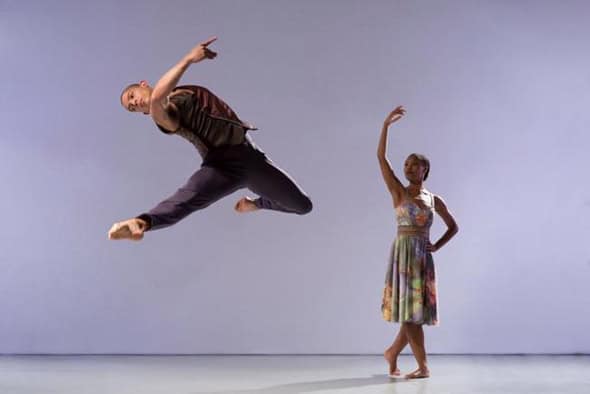Richard Alston Dance Company in Final Edition at Snape Maltings
Posted: November 8th, 2019 | Author: Nicholas Minns | Filed under: Performance | Tags: Akira Miyoshi, Alejandra Gissler, Benjamin Britten, Ellen Yilma, Elly Braund, Fotini Dimou, Jennifer Hayes, Katherine McIndoe, Liam Riddick, Lizzie Fargher, Martin Lawrance, Merce Cunningham, Oihana Vesga Bujan, Peter Todd, Richard Alston, Sir Frederick Ashton, Snape Maltings, WH Auden, Zeynep Kepekli | Comments Off on Richard Alston Dance Company in Final Edition at Snape MaltingsRichard Alston Dance Company, Final Edition, Snape Maltings, November 1

There is a natural link between Richard Alston and Snape Maltings through his long association with the music of Benjamin Britten, while his particular style of dance relishes the space afforded by the extraordinary stage area with its brick walls as precipitous as a cathedral nave and as expansive as a concert hall. Alston’s aesthetic seems to value the sanctity of choreography and music without wanting to divert too much attention from it, presenting his company like an orchestra on a concert platform — which is why Snape Maltings works so well for him. For the theatrical element, lighting designer Zeynep Kepekli washes the brick walls with colour while she enhances the clarity of the dancers against the grand scale of the space. But as soon as she inserts her own individuality, as in the rectangle of light she creates for Ellen Yilma and Jennifer Hayes at the end of their duet in Shine On, the image of a tomb seems too overtly representational for Alston’s choreographic imagery. Costumes for the men tend towards a puritan ethic, casual and utilitarian without embellishments, elegant variations on tracksuit pants and sleeveless tops, where bare arms show off Alston’s love of drawing and carving figures in space. The women are more colourful, especially in Brahms Hungarian where Fotini Dimou’s floral patterned dresses move around the body with a joie de vivre inherent in Brahms’ folk-inspired music. In Voices and Light Footsteps, Peter Todd’s costumes and associate choreographer Martin Lawrance’s lighting work together like a painting, where Alejandra Gissler’s red dress is the dynamic equivalent of one of JMW Turner’s painterly red marks.
Alston’s choreographic style, derived from his two major influences of Sir Frederick Ashton and Merce Cunningham, combines a sparse but reverent classical technique with a romantic, flowing use of the upper body; his vocabulary is not broad but the interest and integrity of what we see is supported by his impeccable musicality that in turn demands the same of his dancers. Personality makes up for a lot in the present company, but musicality is not what it was when the likes of Liam Riddick and Oihana Vesga Bujan were performing, though Elly Braund is still there as a valuable guide. In watching the dancers there’s a suggestion of too much tension in the arms that at speed does not support Alston’s flow of the upper body, and a tendency, especially among the men, to land too heavily. There is something sensuous about soft, pliant landings that goes a long way towards bringing the choreography and the music seamlessly together.
Over several years Alston’s company has had its portion of Arts Council funding to The Place — where it has been resident for the past quarter of a century — successively reduced to the point he feels he cannot run the company to the standards he needs; the present tour is called Final Edition. On the program is a relatively new repertoire, with two works from this year (Voices and Light Footsteps, and Shine On) and two from 2018 (Detour, and Brahms Hungarian). Voices and Light Footsteps, to a selection of Monteverdi madrigals, balli and sinfonia, sees Alston’s choreographic invention soaring with the music, creating a series of courtly dances that sweep up the voices into the air; there is a joy about the work that belies the tumultuous year in which it was created. Lawrance’s Detour, played out to a percussive score by Akira Miyoshi for solo marimba, is a contrast both in its dynamic pace and in the predominance of masculine energy; it features whipping arms and legs in a fast and furious choreography with brute overtones of anger and frustration.
Shine On, to Britten’s early song cycle On This Island for piano and voice (performed respectively by Jason Ridgeway and Katherine McIndoe), is clearly dark in tone, drawing its choreographic line from WH Auden’s poetry that begins with a fanfare (Let the florid music praise!) and turns through the haunting Nocturne to irrevocable loss (As it is, plenty). The symbolism is evident, and yet Alston returns in the finale to the opening musical fanfare with the dancers finishing in a reverence towards the public. Alston dedicates the work to Lizzie Fargher ‘whose enthusiasm for dance (and music) has sustained and encouraged me every time I have been to Snape and to Dance East.’
In closing the program with Brahms Hungarian Alston shows his undefeated spirit with a suite of dances to Brahms’ Hungarian Dances for solo piano that Ridgeway plays with gusto. As Alston remarked stoically after the final applause, “I love this place and I’m not going to say goodbye!”